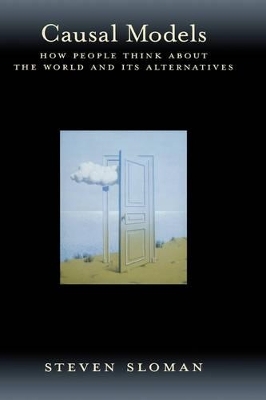
Causal Models
How People Think about the World and Its Alternatives
Seiten
2005
Oxford University Press Inc (Verlag)
978-0-19-518311-5 (ISBN)
Oxford University Press Inc (Verlag)
978-0-19-518311-5 (ISBN)
This book offers a discussion about how people think, talk, learn, and explain things in causal terms in terms of action and manipulation. Sloman also reviews the role of causality, causal models, and intervention in the basic human cognitive functions: decision making, reasoning, judgement, categorization, inductive inference, language, and learning.
Human beings are active agents who can think. To understand how thought serves action requires understanding how people conceive of the relation between cause and effect, that is, between action and outcome.
In cognitive terms, the question becomes one of how people construct and reason with the causal models we use to represent our world. A revolution is occuring in how statisticians, philosophers, and computer scientists answer this question. These fields have ushered in new insights about causal models by thinking about how to represent causal structure mathematically, in a framework that uses graphs and probability theory to develop what are called 'causal Bayesian networks'. The framework starts with the idea that the purpose of causal structure is to understand and predict the effects of intervention: How does intervening on one thing affect other things? This question is not merely about probability (or logic), but about action. The framework offers a new understanding of mind: Thought is about the effects of intervention, so cognition is thereby intimately tied to actions that take place either in the actual physical world or in imagination, in counterfactual worlds.
In this book, Steven Sloman offers a conceptual introduction to the key mathematical ideas in the framework, presenting them in a non-technical way, by focusing on the intuitions rather than the theorems. He tries to show why the ideas are important to understanding how people explain things, and why it is so central to human action to think not only about the world as it is, but also about the world as it could be. Sloman also reviews the role of causality, causal models, and intervention in the basic human cognitive functions: decision making, reasoning, judgement, categorization, inductive inference, language, and learning. In short, this book offers a discussion about how people think, talk, learn, and explain things in causal terms - in terms of action and manipulation.
Human beings are active agents who can think. To understand how thought serves action requires understanding how people conceive of the relation between cause and effect, that is, between action and outcome.
In cognitive terms, the question becomes one of how people construct and reason with the causal models we use to represent our world. A revolution is occuring in how statisticians, philosophers, and computer scientists answer this question. These fields have ushered in new insights about causal models by thinking about how to represent causal structure mathematically, in a framework that uses graphs and probability theory to develop what are called 'causal Bayesian networks'. The framework starts with the idea that the purpose of causal structure is to understand and predict the effects of intervention: How does intervening on one thing affect other things? This question is not merely about probability (or logic), but about action. The framework offers a new understanding of mind: Thought is about the effects of intervention, so cognition is thereby intimately tied to actions that take place either in the actual physical world or in imagination, in counterfactual worlds.
In this book, Steven Sloman offers a conceptual introduction to the key mathematical ideas in the framework, presenting them in a non-technical way, by focusing on the intuitions rather than the theorems. He tries to show why the ideas are important to understanding how people explain things, and why it is so central to human action to think not only about the world as it is, but also about the world as it could be. Sloman also reviews the role of causality, causal models, and intervention in the basic human cognitive functions: decision making, reasoning, judgement, categorization, inductive inference, language, and learning. In short, this book offers a discussion about how people think, talk, learn, and explain things in causal terms - in terms of action and manipulation.
Steven Sloman has been on the faculty in Cognitive and Linguistic Sciences at Brown University since 1992. He completed his undergraduate studies at the University of Toronto in 1986 and received a Ph.D. in Psychology from Stanford in 1990. He has published many papers and a book about human cognition on topics ranging from categorization and memory to decision-making, inductive inference, and reasoning.
PART 1: THE THEORY; PART 2: EVIDENCE AND APPLICATION
| Erscheint lt. Verlag | 18.8.2005 |
|---|---|
| Zusatzinfo | numerous figures |
| Verlagsort | New York |
| Sprache | englisch |
| Maße | 156 x 234 mm |
| Gewicht | 499 g |
| Themenwelt | Geisteswissenschaften ► Philosophie ► Erkenntnistheorie / Wissenschaftstheorie |
| Geisteswissenschaften ► Psychologie ► Allgemeine Psychologie | |
| Geisteswissenschaften ► Psychologie ► Test in der Psychologie | |
| Geisteswissenschaften ► Psychologie ► Verhaltenstherapie | |
| ISBN-10 | 0-19-518311-8 / 0195183118 |
| ISBN-13 | 978-0-19-518311-5 / 9780195183115 |
| Zustand | Neuware |
| Haben Sie eine Frage zum Produkt? |
Mehr entdecken
aus dem Bereich
aus dem Bereich
die Grundlegung der modernen Philosophie
Buch | Softcover (2023)
C.H.Beck (Verlag)
CHF 25,20
Buch | Softcover (2023)
Reclam, Philipp (Verlag)
CHF 9,80

![Was heißt Denken?. Vorlesung Wintersemester 1951/52. [Was bedeutet das alles?] - Martin Heidegger](/media/113619842)
